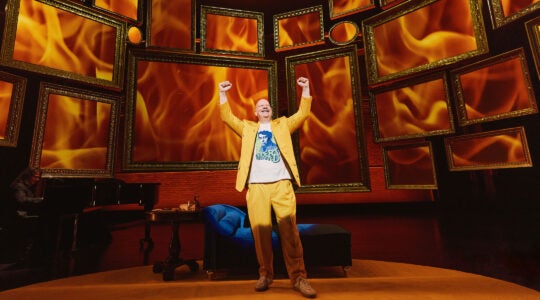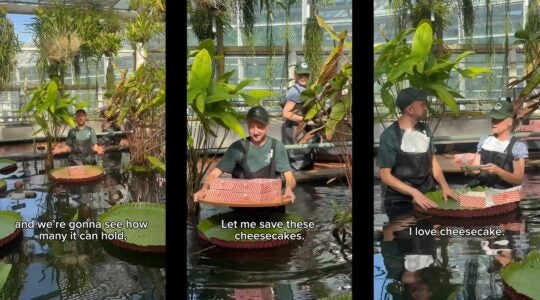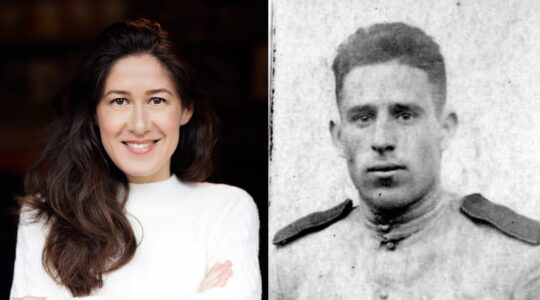The pairing of two paintings in The Jewish Museum’s 2008 blockbuster exhibition, “Action Abstraction,” made a lasting impression on many, including the exhibit’s curator, Norman Kleeblatt.
“It was a wonderful surprise,” he said of Lee Krasner’s “Untitled” (1948) and Norman Lewis’ “Twilight Sounds” (1947). “They are both highly personal, with culturally specific ideas in them.”
And now the two paintings, Krasner’s rectangular composition on pressed wood consisting of white glyphs painted in boxes of muted colors, and Lewis’ black, white and brightly colored shapes and lines set against a blue background, are together again in a new exhibit at the museum.
While “Action Abstraction” sought to explore the Jewish role in painting after World War II, “From the Margins: Lee Krasner and Norman Lewis, 1945-1952,” a spin-off currently on view at the museum, presents two Abstract Expressionists who were largely overlooked in their day. Since they have not been celebrated the way their peers have been, many of the works in the exhibit are rarely on display, and the curators’ statement that accompanies the exhibit suggest this had something to do with the fact that neither artist was both white and male.
The show emphasizes Lewis and Krasner’s similarities: The two artists were born to immigrant parents and raised in New York City; Krasner’s parents were Russian Jews in Brooklyn and Lewis was the son of Bermudians in Harlem. Both painters were hired to make art by the Work Projects Administration in the 1930s, for which Krasner was a supervisor.
The stylistic similarities are great too: both artists were inspired by Picasso, Mondrian and the Bauhaus school. They employed webs of formal and organic lines, and created works inspired by letters and forms of writing, ancient art and contemporary culture such as music, to produce anti-representational paintings of a modest scale. Lewis painted in his Harlem apartment, Krasner in a small bedroom in her home in Springs, East Hampton.
Even though Abstract Expressionism was a movement that embraced immigrants, bohemians and other types of outsiders, some, like Lewis and Krasner, were not accepted. Biology, namely gender and race, kept Krasner and Lewis from the levels of success enjoyed by the titans of the Abstract Expressionist movement. Though they ran in the social circles of the top artists of the day and toiled alongside artists more renowned and successful, neither Krasner nor Lewis reached such levels of fame and recognition. Both felt stymied by what they couldn’t change.
Krasner was married to the most famous first-generation Abstract Expressionist, Jackson Pollock, and had access to the right critics and dealers. Lewis showed at the Marian Willard Gallery, a top space, and was connected to prominent artists such as Ad Reinhardt, who was a close friend. However, the struggle for attention was a large part of the artist experience for Lewis and Krasner.
The heart of the show couples Lewis’ “Little Figure” paintings with Krasner’s “Little Image” series. The “Little Image” and “Little Figure” paintings were made in the late 1940s. Krasner’s “Little Image” paintings were painted from right to left, likely in reference to the Hebrew lessons she received as a child in Brooklyn. An essay in the exhibition catalogue links their genesis to cryptography and decoding tablets from Knossos. These works are dense, gridded, and very textural.
The “Little Figure” paintings demonstrate Lewis’ interest in linear abstraction. They were inspired by his life in Harlem, and include references to jazz musicians and street life.
Highlights in “From the Margins” include Lewis’ “Every Atom Glows: Electrons in Luminous Vibration” (1951), a smoky, rectangular composition in tones of black and white. Lewis used a dry brush technique on unprimed canvas to convey mist in his “Just Firmament,” also from 1951.
Krasner’s “Stop and Go” from 1949, a tondo, is a tight web of lines evoking hieroglyphics. In “Promenade” (1950) she painted vertical forms that reach from the top to the bottom of the board. The title and the forms, which are reminiscent of figures, suggest people walking.
“From the Margins” explores each painter’s background and influences; each painter’s art is given a respectful presentation, and the synergy between the two artists’ works is clear. However, the relationship between Krasner and Lewis remains somewhat of a mystery. Although it is acknowledged that they knew each other, the extent of their relationship is still unknown, making clear how much new research there is still to be done even for this popular era in art history.
“From the Margins: Lee Krasner and Norman Lewis, 1945-1952” is on view through Feb. 1, 2015 at The Jewish Museum, Fifth Avenue at 92nd Street. thejewishmuseum.org.
The New York Jewish Week brings you the stories behind the headlines, keeping you connected to Jewish life in New York. Help sustain the reporting you trust by donating today.




